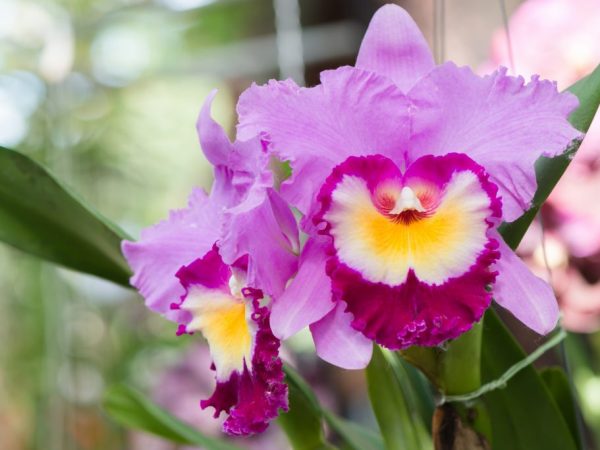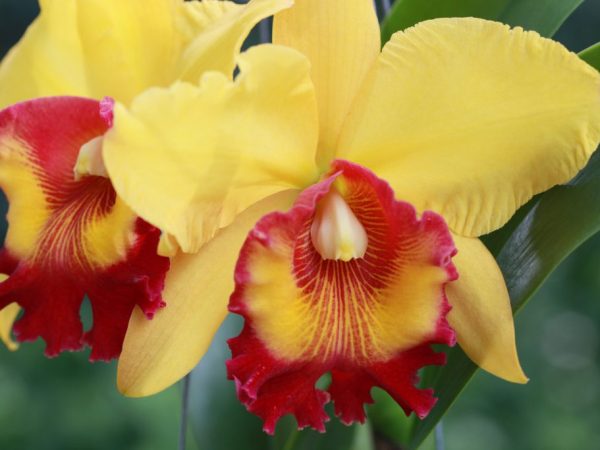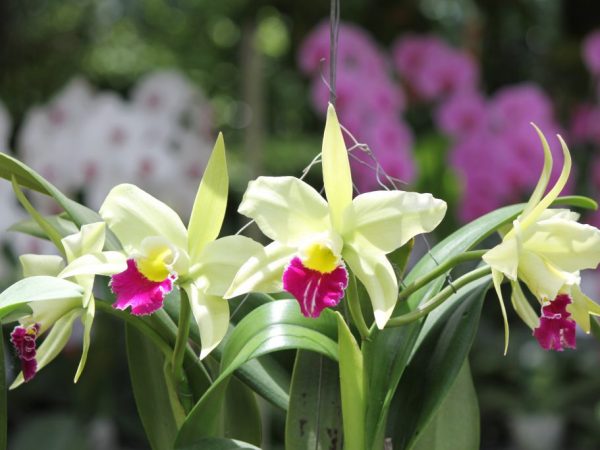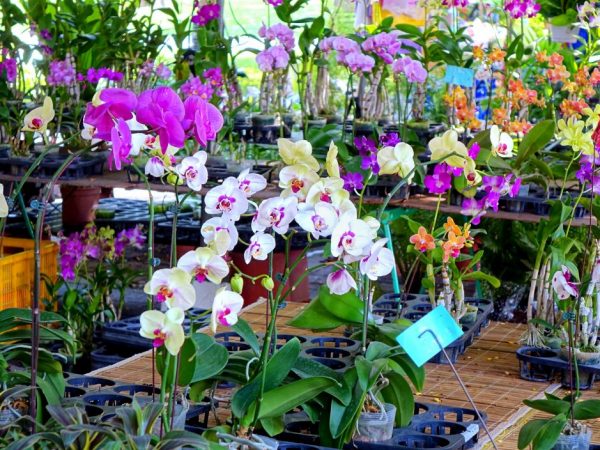Growing Cattleya Orchids
Cattleya Orchid is the name of a subspecies of large-flowered orchids that attract attention with bright colors of delicate flowers. There are about 40 varieties of Cattleya. The plant is capricious, so it needs to be properly cared for.

Growing Cattleya Orchids
Necessary growing conditions
Growing a flower takes a lot of time and effort. He must provide a certain temperature and light conditions, a normal level of humidity.
Shine
Cattleya hybrid is grown on windowsills in the southern part of the apartment. They need a lot of light. With a short daylight hours, hybrid flowerpots are additionally illuminated. The lack of light is indicated by the dark green color of the leaf plates; with an excess of it, they become pale yellow. Lack or overabundance of light also affects the color intensity of the buds. The length of daylight hours varies for each variety. On average, it should be 12 hours, but they are guided not by this norm, but by the state of the flowerpot.
Do not allow direct sunlight to fall on the flowerpot.
Temperature regime
Cattleya's orchid feels great at room temperature from 20 ° C to 25 ° C during the day and from 16 ° C to 20 ° C at night.
Do not overheat the leaves. If in summer the temperature rises above normal, the flowerpot is wiped with a damp cloth several times a day. Also, at least once every 2 days, the plant is given a shower. After the shower, the flowerpot is left in the bathroom so that excess moisture leaves the pot. For active flowering, make sure that the night temperature is 5-7 ° C lower than the daytime, so the flowering periods fall in spring and autumn. Sometimes, in order to force the flowerpot to release buds, a difference is artificially created between night and day temperatures.
At elevated temperatures, peduncle formation does not occur.

The optimum temperature during the day is from 20 to 25 ° C, at night from 16 to 20 °.
Humidity
Cattleyas are undemanding to humidity. This makes it easier to care for them. To provide the flowers with comfortable conditions, water is poured into the sump during the warm period. If the room has low humidity, units are installed to increase the humidity of the air, and the flowerpot is sprayed. When spraying, water should not come into contact with the buds.
Cattleya care secrets
If you follow simple rules, caring for this type of orchid will not be a hassle.
Organization of watering
Cattleya orchids love water, so they are often watered. The substrate must be constantly moist. During watering, water should not fall on the stems of the plant. After the orchid has faded, the amount of watering is reduced. In the same period, the substrate is sprayed. After the end of flowering, the covers ripen, in which flower stalks are laid.
In winter and early spring, make sure that during watering, water does not fall on the leaves of the flowerpot, otherwise brown specks appear on them.
The substrate is washed monthly with running water. In this case, the flower is not taken out of the pot.
Top dressing
Phalaenopsis needs additional fertilizing, which is carried out after the flowering of flowerpots. During this period, pseudobulbs (false bulbs) grow, on which the plant spends a lot of energy. After the growth of the pseudobulbs has ended, the pot is no longer fertilized. The second series of dressings is carried out during the growth of the peduncle. As soon as the flowering period has begun, feeding is stopped.
Root and leaf care
The Cattleya Orchid has a developed root system. Examine the roots of the plant: they periodically die off. During transplantation, plants at home get rid of dead roots. Rotten or damaged areas must also be removed.

Orchid care rules
The leaf plates are monitored no less carefully. Dust is removed from the leaves and examined for the presence of parasitic insects. When spots of any color appear, they are dismantled, which was the reason for this phenomenon.
Transfer
The Cattleya orchid is transplanted every 2 years. This process is stressful for the plant. The soil, consisting of pine bark and sphagnum moss, is carefully prepared. The bark is taken in small and medium fractions. 2 days before transplanting phalaenopsis, the bark is placed in water. After the time has elapsed, the water is drained, and the bark is washed.
A layer of gravel is laid in a pot intended for planting phalaenopsis, the height of which is 2 cm. Expanded clay acts as an alternative to gravel. A layer of gravel is covered with bark, a small amount of foam is added to it. After that, an orchid is placed in a pot and sprinkled with bark with sphagnum moss. So that moisture from the substrate does not go away so quickly, a little perlite is added during transplantation.
Reproduction
At home, the easiest way to reproduce is by dividing the bush. The orchid does not tolerate transplantation, these procedures are combined. Reproduction is carried out during the formation of new roots.
First, the flower, along with the substrate, is taken out of the pot. To make the procedure the least traumatic for the roots, the substrate is soaked. For this, the plant for 30-40 minutes. placed in a container with water.

Reproduction occurs during the formation of new roots.
After the expiration of time, the root system is freed from the sodden bark and substrate. This is also done in water. Then the roots are disinfected by sprinkling them with ash or crushed coal. If neither the first nor the second is at hand, use cinnamon. After drying the roots, the plant is divided. Each new bush should have at least 3 bulbs and a maximum number of roots. The roots are re-treated with ash. At this reproduction by division is over, it remains to plant the bushes in pots.
All instruments used are pre-sterilized.
Reproduction is carried out with the help of children, which have formed their own roots and 2-3 leaf plates. The baby is separated from the bush for 120 minutes. soaked in a growth stimulant and planted in a separate pot. Planting children is carried out in the same way as planting an adult plant.
Raising babies has no specific features. Cattleyas grown from babies have all the qualities of a parent bush. To help grow babies, the flower is treated with cytokinin paste. Cut sections of phalaenopsis are disinfected. It is difficult to grow phalaenopsis at home from seeds.
Cattleya live about 8-10 years. Depending on how the cultivation takes place, the life span of the phalaenopsis increases or decreases. Sometimes flowers live up to 15-17 years.
Common growing problems
Cattleya hybrid has some difficulties in growing:
- Diseases and pests cause flowering to stop. Most often, phalaenopsis affects scale insects and spider mites. Insects are eliminated with mild insecticides. Folk remedies are ineffective in pest control.
- If the phalaenopsis cannot bloom, it either lacks certain trace elements, or there are too many of them. Most of all, the orchid needs magnesium.
- With the accumulation of moisture in the root part of the flowerpot, covered with scales, the stem decays. The damaged area turns black. The affected elements are cut out with a sharp knife and disinfected.
- If the conditions of maintenance are not observed, the growth of the root system does not occur. To normalize the growth process, it is necessary to water the plant in a timely manner and provide it with a light regime. In parallel, growth stimulants are used for phalaenopsis.
- The orchid is affected by fungal infections, which are eliminated with the help of antifungal drugs. With fungal infections, the leaves turn brown or dark spots appear. Previously, all damaged parts of the plant, including roots, bulbs and buds, are cut out and sprinkled with ash. The most common fungal diseases are gray and black rot, anthracosis and mosaic disease. If the disease is not treated in a timely manner, the plant dies. Resuscitation does not help in advanced cases.
- If the peduncle dries up before buds appear, the phalaenopsis lacks water, light or nutrients.
- If a plant has shriveled leaves, it lacks moisture, the roots begin to rot or the humidity of the air is low.
- If leaves wither on Cattleya, overheating or root damage occurs.
- The appearance of cracks on pseudobulbs indicates an excess of nitrogen.
Varieties of Cattleya
There are different types of Cattleyas. According to the structure of the leaf plates, they are divided into single-leaved and double-leaved. A single-leaf orchid is characterized by the formation of 1 leaf plate on each bulb. Two-leaved Catalea is distinguished by the formation of 2-3 leaves on each bulb.
Noteworthy is Moss's phalaenopsis, one pink or lilac flower of which reaches 13 cm in length. Forbes orchid is the least demanding on the conditions of keeping.
Phalaenopsis Varshevich has white side petals and a purple cylindrical core. The length of the bulb sometimes reaches 30 cm.

There are different types of Cattleya
The miniature lipped Cattleya looks bright. Its petals are deep pink or purple.
White Cattleya is also popular, which produces a large bud. Blooming buds of Terry Cattleya attract attention with the wavy edges of the petals. It is easy to grow Cattleya Schroeder at home, which has white petals and an orange or yellow core.
Such types of Cattleya as Astilba, Godezia, Lueddemanniana, Eagle Eye, Nobilior, Cardiad, Triana, Dinard, Arends, Blc attract attention. Patum Green, Black Jack, Flask, Labiata, Queen, Tuberidia, Nardotto, Evergarden, Violet, Baudelaire, Green-flowered. A description of each of the Cattleya phalaenopsis species is located on the seed package.
Blue phalaenopsis are obtained by dyeing - in the second generation, the orchid will give white buds.
Conclusion
With proper care, Cattleya pleases with a long and friendly flowering twice a year. For living quarters, the least capricious varieties are chosen, which feel comfortable in conditions of normal humidity.


